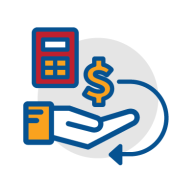
Finances
Appropriate management of funds is critical to any organization's success. For nutrition programs, this requires an understanding of how to make the most of limited resources; how to generate revenue for your program through voluntary contributions, fundraising, and other means; how to identify and, when possible, reduce the cost of doing business; and how to make the most of limited resources. Remember, federal grant funds typically cannot be used to pay the costs of organized fundraising, including staff time; see 2CFR § 200.442.
 Quick Guides
Quick Guides
- Recipe for Success: Fundraising (YouTube)— Bite-sized video with tips on fundraising (ACL, 2024)
- Beginners Guide To Diversifying Funding — Inspiration from successful programs and other helpful resources for funding options (Nutrition and Aging Resource Center)
- Identifying the Total Cost of a Meal — Summary brief for meal cost calculations (Nutrition and Aging Resource Center)
- Sustainability and Revenue Generation for Senior Nutrition Programs — Summary brief (Nutrition and Aging Resource Center)
- The Roadmap to Community-Integrated Health Care— Resources for pursuing complex sustainability strategies and stronger partnerships with the health care sector (National Council on Aging)
- Maximizing Use of Commercial Kitchens for Senior Nutrition Programs — Opportunities and challenges (Nutrition and Aging Resource Center)
- Quick Tips: Funding Options — Information and resources related to common questions on funding for OAA Title III-C Nutrition Services (Nutrition and Aging Resource Center)
- Writing Competitive Grants— Keys to successful grant applications (National Council on Aging, 2022)
 Guides
Guides
- The Amazing Adventures of Captain Funds Finder — Comic-style guide to finding and securing various funding sources (Nutrition and Aging Resource Center)
- Meal Services Elements of Sustainability: Establishing a Private Pay Program — Guide to establishing a fee-for-service private pay system (Nutrition and Aging Resource Center, 2020)
- How Attachment Uploads Can Make Or Break Your Grant Application— Article on how to organize attachments for applications (National Council on Aging, 2023)
- Community Care Hubs: Quality, Fidelity, and Compliance Expectations for Service Delivery Partners— Resource about ensuring CCH success (National Council on Aging, 2023)
- Community Care Hubs: What Evidence-Based Program Providers Need to Know— Resource about how participating in a network eases burdens and enables providers to serve more people (National Council on Aging, 2023)
- How Evidence-Based Program Providers and Accountable Care Organizations Can Work Together on Quality and Performance Improvement— Resource about how these partnerships can be beneficial (National Council on Aging, 2023)
- Updated Medicare Reimbursement Rule Addresses Health-Related Social Needs and Care Coordination— Resource about a new final regulation that allows for reimbursement for services that address a person’s health-related social needs (National Council on Aging, 2023)
- Use of Incentives for Older Americans Act Grantees — Definition and examples of incentives (Nutrition and Aging Resource Center, 2021)
- Business Planning & Sustainability— Article with business plan and sustainability toolkits (National Council on Aging, 2021)
 Presentations
Presentations
- Employee Retention Credit: The Payroll Protection Program’s Sibling— One-hour webinar that discusses the loan-free Employee Retention Credit (ERC) grant (SCORE, 2023)
- Building Blocks for Participating in a Coordinated Network of Community-Based Organizations— Series of four one-hour webinars that highlight different components to serve as an effective partner in a coordinated network (free registration required to view the videos) (National Council on Aging, 2023)
- Medicaid Opportunities for Evidence-Based Program Sustainability— Series of four 90-minute webinars about Medicaid programming and experiences from CBOs on their journeys to Medicaid reimbursement (free registration required to view the videos) (National Council on Aging)
- Beyond Fundraising Series (YouTube)— Senior Nutrition Program fireside chats to help programs succeed in various endeavors such as enhancing collaboration to attract volunteers, sustaining grab-and-go, prioritizing participants, and setting up non-OAA-funded expansion programs to reach people with disabilities (ACL, 2023)
- Introduction to Social Entrepreneurship and Implications for Sustainability— 90-minute webinar (free registration required to view the video) (National Council on Aging, 2023)
- Food 911: How Meals on Wheels Redefines Population Health— Sixteen-minute webinar that discusses the frailty scale screening and a health economist’s return-on-investment analysis of home and community-based program impacts (ACL, 2021)
- Creative Fundraising for Senior Nutrition Programs (YouTube)— One-hour webinar exploring creative ways to sustain senior nutrition programs through fundraising efforts (ACL, 2023)
- Giving Big: Trends in Philanthropic Support for Aging— One-hour webinar on the latest trends in philanthropy and their impact on the field of aging (free registration required to view the video) (National Council on Aging, 2023)
- How Nutrition Services Boost Your Bottom Line — Presentation about how nutrition services can offer cost savings (Nutrition and Aging Resource Center)
- Sharing Financing Experiences— Presentation (Nutrition and Aging Resource Center)
 Grants
Grants
- Looking Beyond ACL: Expanding Federal Funding Opportunities Through Creative Grant Prospect Research— One-hour webinar that will help participants understand how to find “non-traditional” sources of federal funding (free registration required to view the video) (National Council on Aging, 2023)
- What Your Organization Needs To Know About Applying for Grants— One-hour presentation on telling your organization’s story, articulating your need, finding funders, preparing the proposal, and reporting requirements (SCORE, 2023)
- Top Five Ways To Prepare for a Notice of Funding Opportunity— Article on using your time strategically and working with partners (National Council on Aging, 2022)
- Tips for Sustaining a Project Beyond the Grant Period— Multi-prong sustainability plan (National Council on Aging, 2023)
- Tips for Developing a Compelling Budget Justification Presentation for a Grant Proposal— Article on budget narratives (National Council on Aging, 2022)

